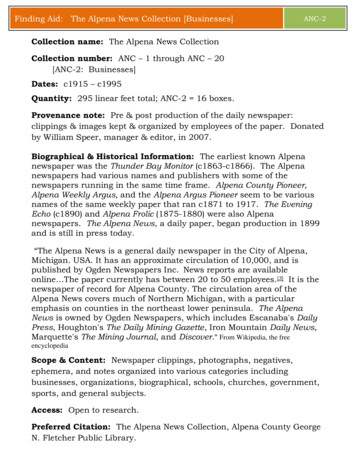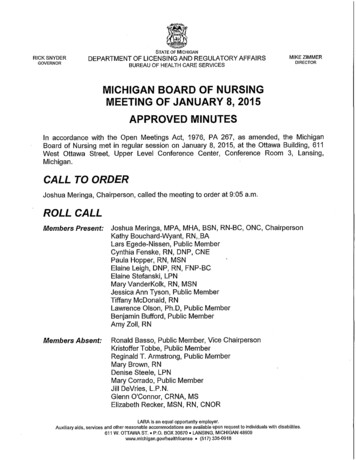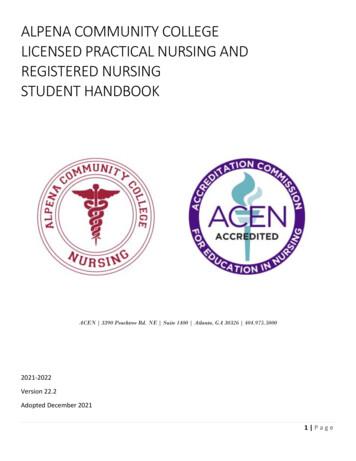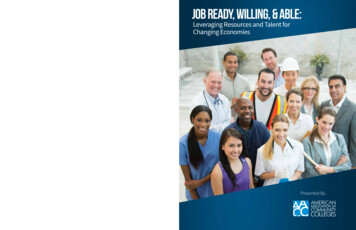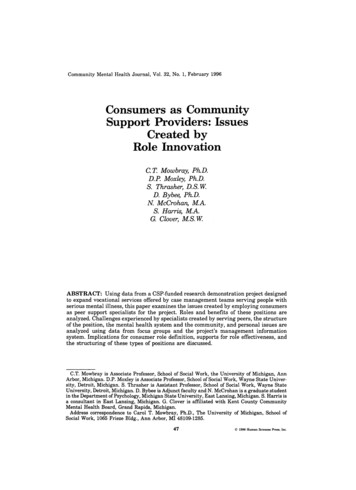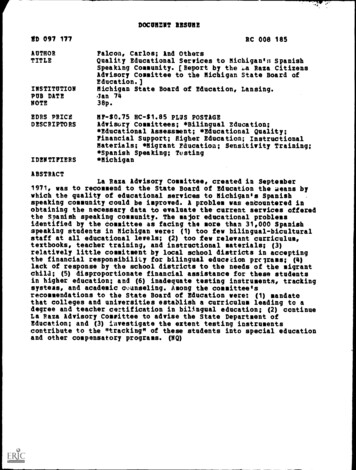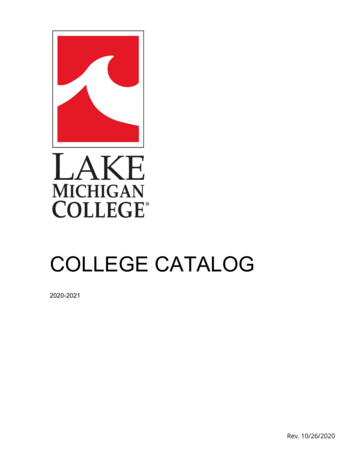
Transcription
Alpena Community CollegeAlpena, MichiganFive-Year Capital Outlay PlanFY2022-2026Submitted October 2020
Table of ContentsI.Mission Statement. 2II.Instructional Programming . 3III.Staffing and Enrollment . 7IV.Facility Assessment . 12V.Implementation Plan . 66VI.Source Material: Economic Contribution Study . 67I.Mission StatementThe College MissionThe mission of Alpena Community College is to create a culture of educational excellence andservice to the community.The College Goals(1)Campus/CultureOffer a welcoming, safe, and adaptable culture that inspires diversity.(2)Learning/EducationMotivate continuous exploration of diverse opportunities and knowledge acquisitionthrough a flexible learning environment.(3)CommunityStimulate community collaboration, which fosters comprehensive economic, cultural, andcommunity development.(4)ValueExercise sustainable value that supports career pathways and fiscal responsibility.The College VisionTo be recognized in our local and global communities as the premier resource and first choice forexceptional, affordable, and innovative education.Alpena Community College Five-Year Capital Outlay Plan 2022-26, pg. 2
The College Values II.We demonstrate accountability to all our stakeholders, students, staff, business partners,industry alliances, and taxpayers.We act with integrity, placing fairness and honesty at the center of all our actions.We aspire to excellence in all our endeavors.We show respect for diversity, individual contributions, and educational partnerships.Instructional Programminga.Existing Academic ProgramsACC offers the Associate in Arts and Associate in Science degrees for studentswho plan to transfer to a four-year institution after two years of study.Associate in Arts Concentrations AnthropologyBusiness InformationSystemsComputer InformationSystemsCriminal JusticeEconomicsEducation, ElementaryEducation, SecondaryEducation, Vocational EnglishFine ArtsGeographyHistoryLiberal ArtsPolitical SciencePre-LawPsychologySocial WorkSociology Pre-Fisheries andWildlifePre-Medical harmacyPre-Physical logyAssociate in Science Concentrations BiologyChemistryComputer ScienceGeneral SciencesMathematicsNatural lPre-Engineering Alpena Community College Five-Year Capital Outlay Plan 2022-26, pg. 3
The Associate of Applied Science degree marks the progress of students seekingemployment after graduation from a variety of two-year programs. Current majorsfor the AAS degree include the following. AccountingAuto Service and RepairBusiness InformationSystemsBusiness ManagementCADD TechnologyCAD/CAM Technology(Machining Option andWelding Option)Concrete TechnologyCorrectionsCustomer Energy ServiceElectrical MaintenanceTechnician Industrial SalesLaw EnforcementManufacturingTechnologyMarine TechnologyMarketingMedical AssistantMedical Coder and BillerMillwright TechnicianNetwork AdministrationNursingSmall BusinessManagementUtility TechnicianThe Certificate award marks the progress of students seeking employment aftergraduation from a variety of one-year programs. Certificate awards are currentlymade in these fields. Apprentice – ElectricalApprentice – MillwrightAuto Body RepairAuto Service and RepairBusiness InformationSystemsCAD/CAM, AdvancedConstruction Technology– Green BuildingCorrections OfficerCustomer Energy Service Industrial TechnologyManufacturingTechnologyNetwork AdministrationLicensed PracticalNursingSmall BusinessManagementUtility TechnicianWelding FabricationAlpena Community College Five-Year Capital Outlay Plan 2022-26, pg. 4
ACC projects the following programming changes will be affected by structuralconsiderations: ACC has successfully transformed its highly successful UtilityTechnology and Electrical Apprentice programs into a comprehensive andcoordinated set of electrical power offerings linked to the State ofMichigan’s growing markets and alternative energy initiatives. Factorsconverging to justify this pursuit include: The statewide reach of ACC’s electrical programs in terms ofrecruitment of students; alliances with power companies, tradeassociations, and unions; and employment of graduates. Readiness of ACC’s electrical faculty to advance curriculum andinstruction into wind, solar, and biomass for energy production anddistribution. Recent authorization for community colleges to offer bachelor’sdegrees in the field of energy production. At ACC a BS degree inElectrical Systems Technology has been created, and work to upgradeaccreditation with the Higher Learning Commission has be approved. Authorization by the Higher Learning Commission in September 2015for ACC to offer a Baccalaureate degree in Electrical SystemsTechnology. On June 25, 2012, Governor Snyder signed legislation makingprovision for the State of Michigan to fund half the 5 million cost ofACC’s Electrical Power Technology Center, in which thesetransformations will take place. ACC successfully launched its Baccalaureate degree in ElectricalSystems Technology in fall 2016. Recently mandated discipline-specific accreditation guidelines from theAccreditation Commission for Education in Nursing and the State ofMichigan have necessitated curriculum changes involving increasedclinical hours. Because of these increases, ACC has hired three additionalfull-time faculty members while increasing intake of LPN and RNstudents to 48 per year. Our ACEN application was approved with finalaward of accreditation in March 2017. The FY17 capital outlay projectrequest aligned with this direction, calling for renovations of the Van LareHall to make it dedicated to nursing classrooms and laboratories. This 8.695 million repurposing project is underway and is expected to becomplete by March 31, 2011. ACC has also moved forward with nursing pre-requisite classes at theOscoda branch campus, and has created an LPN track fully obtainableAlpena Community College Five-Year Capital Outlay Plan 2022-26, pg. 5
there by residents of Iosco County and southern Alcona County. Plans toexpand the LPN to include an RN track are underway.b. Obtaining Bachelor of Science in Nursing (BSN) authorization is a highpriority for the College. Admissions, academic advising, registration, tutoring, career placement,testing, and counseling services are offered to ACC students at severalMain Campus locations dispersed on both sides of the Johnson Street. Atmost community colleges the necessity of sending students to multiplestops across campus has been mitigated by organization of one-stop shopcenters for delivery of these and other services to students. Based ondocumented better results, the renovation of Van Lare Hall to incorporatea Center for Student Success where necessary student support services arecentralized makes sense for ACC and its students.Unique CharacteristicsThe Concrete Technology AAS program at ACC is one of only two in the nation.It operates out of the World Center for Concrete Technology on the ACC MainCampus alongside incumbent worker training and research/testing performed as aservice to the concrete industry.The Utility Technology (lineworkers) program is also nearly unique, with onlyone other similar program offered at a Michigan community college. Graduatesof this program enter employment with electrical cooperatives, municipalities,and at large energy providers such as Consumers Energy. It is not uncommon forUtility Tech graduates to enter employment at a starting wage of 37/hr.No other community college in Northern Michigan or the Upper Peninsula offersthe range of manufacturing technology programs found at ACC, including MarineTechnology and customized training in drones and autonomous aerial vehicles.For at past five years ACC has ranked highly among Michigan communitycolleges in rate of graduation. For the cohort most recently measured in the USDepartment of Education Integrated Post-Secondary Education Data System,ACC’s overall rate of 35% of students graduating within 150% of normal time tocompletion is twice the rate of the other nine comparable Group 1 Michigancommunity colleges.ACC has administered four Department of Labor training grants over the pasttwelve years, the most recent a four-year TAACCCT grant for 2.50 million tointensify workforce development in the fields of advanced manufacturing,aerospace production, cybersecurity, and smart grid technology. ACC receivedthe Department’s 2007 Recognition of Excellence award for the best communitycollege implementation in the nation of training under its first grant. ACC alsoreceived a 2.25 million Title III Strengthening Institutions Program (SIP) grantfrom the United States Department of Education in September 2019.Alpena Community College Five-Year Capital Outlay Plan 2022-26, pg. 6
Alpena Early College in collaboration with Alpena Public Schools is now in its7th year. The May 2019 cohort graduated 38 students earning an average of 51college credits.ACC has boosted enrollment in dual enrollment programs by offering discountedin-district tuition to all K-12 districts enrolling students in our classes. As for aswe are aware, no other college in Michigan pursues this strategy for encouragingaccess by qualified high school students.ACC is fortunate to provide a classroom and office on campus for a very robustAssociation of Lifelong Learners boasting 300 members of all ages and over 160presentations, excursions, and social events per year.As for university partnerships, ACC participates in the new Michigan TransferAgreement, administers numerous other articulation agreements, and performsreverse transfer functions for students who leave us before graduating to beginuniversity study. In addition, ACC’s Madeline Briggs University Center bringsbachelor’s degree programs in business from Northwood University, integrativestudies and information technology from Ferris State University, and nursingfrom University of Michigan – Flint so that local residents have access withoutrelocation or long road trips.c.d.Other Initiatives Affecting Facilities Usage Collaboration with the Alpena Fiber Ring Consortium and Merit Network,Inc., to expand broadband service to the Northeast Lower Peninsula. Successful rollout of an LPN nursing track to the Oscoda Campus, whichentailed building out a nursing instructional laboratory.Economic development ImpactIn general terms, ACC’s economic impact is documented by a study performed in2006 by CCBenefits, Inc. The Fact Sheet is attached at the end of this report in theSource Material section. This document demonstrates that within the five-countycollege service area, the regional economy is 88.1 million stronger per year as aresult of past and present college operations.III.Staffing and Enrollmenta.Enrollment by Program with 10 MajorsPROGRAMMAJORSApprenticeship Millwright Certificate10Automotive Service Certificate10Business Info Systems Adm. Asst.10Mathematics10Marketing10Alpena Community College Five-Year Capital Outlay Plan 2022-26, pg. 7
Apprentice-Electrical CertificatePre PharmacyMillwright TechnicianNetwork AdministrationPre Radiologic TechnologyCAD/CAM Tech (Machining Option)Electrical Maintenance TechnicianEnglishPre Veterinary MedicineMarine TechnologyGeneral StudiesComputer Information SystemsComputer ScienceEducation SecondaryAutomotive Service TechnologySciences GeneralPre EngineeringBiologyLaw EnforcementPre Physical TherapyPsychology - AAAccountingUtility TechnologyLicensed Practical Nursing CertificateBusiness AdministrationWelding Fabrication CertificateFine ArtsPre MedicineSocial WorkMedical AssistantRegistered NursingConcrete TechnologyUtility Technician CertificateCriminal JusticeBusiness ManagementPre NursingLiberal 34353637434444454955586078176280Enrollment projectionsFall semester 2019 ACC was number one among Michigan’s 28 communitycolleges with a 4.5% increase in headcount and credit hours. Affected by theuncertainty caused by the COVID-19 pandemic, fall semester 2020 enrollmentdeclined 4.1% in headcount and 6.8% in credit hours compared to Fall semester2019. This enrollment decline was experienced, and in many cases moreseverely, across Michigan and most of the 1100 community colleges nationally.Some ACC enrollment highlights:Alpena Community College Five-Year Capital Outlay Plan 2022-26, pg. 8
Online course enrollment was up 148.9% in credit hours, and 102.1% inheadcount. Early College enrollment was up 28.9% in credit hours, 23.5% inheadcount. Dual enrollment was up 15.9% in credit hours, 3.8% in headcount. Early College and dual enrollment comprised 40.8% of headcount, and29% in credit hours. Continuing Students and New First Time Students, the largest aggregationof headcount and credit hours, were down more than 15%. ACC finished 3rd among Michigan’s 28 community colleges in headcountbased on data from the Michigan Community College Student ServicesAssociation (MCCSSA), the official report from community collegeregistrars.Over the next five years ACC will be dealing with a number of other factors thatmight cause continued enrollment challenges. Population in Alpena County, thesource of most ACC students, is likely to remain stable with an increasing seniorcitizen component and a decreasing youth component. In addition, tighterrestrictions on federal Pell grants for low-income students has adversely affectedenrollment at all community colleges. To address the local demographics, thecollege continues to follow an annually updated marketing plan, available athttp://discover.alpenacc.edu/about acc/docs/acc marketing plan.pdf. The plancalls for continuing proven strategies and also initiating new emphases ontechnical program recruitment all over the state, Oscoda Campus students, anddual enrollment and Early College partnerships with regional K-12 districts.Introduction of videoconferencing system equipment (VCS) has supportedtechnology-enabled learning across the district served by Alpena CommunityCollege and has been particularly helpful in responding to the COVID-19pandemic. ACC’s innovative work in this area was featured in EDTech magazinein March, a national publication focused on technology innovation in highereducation.Alpena Community College Five-Year Capital Outlay Plan 2022-26, pg. 9
An ongoing enrollment challenge is the regional demographic of NE LowerMichigan, namely, there are fewer graduates every year at every K-12 in thedistrict. Data from Alpena High School, the largest school in the region,illustrates this demographic challenge (see graph below):c.Past ACC Enrollment PatternsAlpena Community College Five-Year Capital Outlay Plan 2022-26, pg. 10
d.RatiosFrom the 2018 Fall Semester through the 2019 Summer Semester, ACC generated29,373 credit hours. This number divided by 30 yields 979 Fiscal Year EquatedStudents (FYES) by the Activities Classification Structure definition. During thesame period the credit students were served by 67 equated full-time facultymembers. Forty-six full-time faculty members provided 74% of instruction bycredit hour, with the remaining 26% provided by adjunct faculty members. Thus,taking 67 equated faculty members for 979 equated students, we arrive at a 1:14.6faculty-student ratio.During the same period ACC’s General Operating Fund supported theemployment of 19.14 administrators. (The other administrators were supported bygrants or auxiliary funds.) This produces a 1:51 administrator-student ratio atACC.e.Future Program Staffing NeedsFor programs affected by the capital outlay plan, no new full-time facultypositions are anticipated.f.Average Class SizeNot counting independent studies or internships, average credit class size for fallsemester of 2019 is 13.Alpena Community College Five-Year Capital Outlay Plan 2022-26, pg. 11
IV.Facility AssessmentFACILITY ASSESSMENT AND DEFERREDMAINTENANCE CAPITAL PLANNING REPORT2015 UPDATEPrepared by SHW GroupCopyright 2008 SHW Group, LLC All rights reserved.The Facilities Assessment and Deferred Maintenance Capital Planning Report and associateddatabase are instruments of service and shall remain the property of SHW Group. SHW Groupshall retain all common law, statutory and other reserved rights, including the copyright thereto.No part of this publication may be reproduced, stored in a retrieval system, or transmitted, in anyform or by any means, electronic, mechanical, photocopying, recording or otherwise, without theprior written permission of SHW Group, LLC.Executive SummaryIntroduction .12Purpose of the Study .13Glossary .14Deferred Maintenance Backlog – A Brief Background .18Condition ReportsCollege Information .19Summary .22Recommendations .22Individual Building Reports .24IntroductionProcess BackgroundSHW Group, in conjunction with the Alpena Community College Facilities staff, performed anupdate to the facility condition assessment of all campus buildings in May 2008.As part of the study, SHW Group staff interviewed campus personnel and performed a walkthrough of each building. Existing conditions, maintenance history, potential problems, andprojected life expectancy of systems and components (including structural, mechanical, andelectrical systems) were recorded.Collected information was analyzed to develop estimates of repair and replacement costs in adatabase format for record-keeping, long-range planning, prioritizing and cost projection.This report contains the printed version of that database.Alpena Community College Five-Year Capital Outlay Plan 2022-26, pg. 12
Condition ReportsHighlights of this data are presented in this section to provide an overview of the condition of theentire College, each facility, and major campus systems. Recommendations for funding, bothimmediate and long term are provided.Individual building reports include additional detail and representative photographs of eachfacility.Database Report PagesThe underlying data used to develop this report and the budgeting recommendations are includedin the appendix. This is the raw data for use and regular updating by facilities staff. Thisinformation is also useful as a permanent record of conditions often retained in multiplelocations, and as an “owner’s manual” for new employees.Purpose of the StudyThis Facilities Assessment and Deferred Maintenance Capital Planning Study, developedthrough a combination of personnel interviews, facility walk-throughs and building systemanalysis, was performed to accomplish the following objectives: Provide an inventory of the College’s facilities in a database format to be easily updated andmaintained by college personnel and allow for quick access to facilities information.Determine the general condition of the buildings and grounds of the college and provide thedata in a concise format, allowing quick determination of the current replacement value andcondition of each facility.Determine a FacilitiesCondition Index (FCI) foreach building and thecollege as a whole. The FCIis a benchmark index thatrates the condition ofexisting college buildingsand is used by facilitiesmanagers to quantify andprioritize deferredmaintenance projects forcapital planning purposes.Assist the college inmeeting the goals of itsMission Statement throughtimely maintenance of thephysical backbone of thecollege – the campus buildings.Alpena Community College Five-Year Capital Outlay Plan 2022-26, pg. 13
GlossaryVital StatisticsBasic building information– building use types (classroom, library, administration), year built,building area in square feet, and number of floors.Observation HighlightsA partial list of field observations, highlighting major repair/replacement items and recentlycompleted work. For a more complete list of field observations, see the individual building datasheets in the appendix.Current Replacement Value (CRV)The CRV is the cost to construct a typical replacement building in today’s dollars. The figure isbased on the square footage of the current structure and the estimated current construction costfor that type of structure. Since some buildings are conglomerations of different uses (i.e.:classroom, library, administration) the CRV is based on estimated proportions of use types ineach building. By the nature of the calculations and square foot construction costs, the currentreplacement value has a 20% margin of error and will increase annually due to inflation.Priority Issues/One Year Deferred Maintenance Backlog (1YR DMB)The value of projects that have been deferred and require completion in order to safely maintainfacilities and related infrastructure for their current use. The 1 Year DMB amounts shown are foritems requiring immediate attention to fix critical problems. A long-term investment strategyshould also include items that require repair or replacement within 5 years, thus avoiding theincreased repair costs resulting from deferred repairs (i.e. leaky roof damaging interior finishes).Facilities Condition Index (FCI)Simply put, the FCI is the current DMB divided by the CRV. The resulting number is comparedagainst nationally accepted standards and used to determine the condition of the building,campus or college.FCI 5% GoodFCI 5% and 10% FairFCI 10% PoorThe Association of Higher Education Facilities Officers (APPA) recommends that the FCI forany given building should not exceed 5% for the building to be considered in “Good” condition.The rating of “Fair” indicates that the building requires some attention to bring it up to standard,with some problems areas potentially requiring immediate attention. The rating of “Poor”indicates that the building needs urgent attention to prevent the existing problems from affectingother building systems and compounding future repair costs.Alpena Community College Five-Year Capital Outlay Plan 2022-26, pg. 14
The APPA FCI Ratings, indicating the general condition of the building, are shown here alongwith the corresponding “traffic signals” that give a quick visual indication of the FCI rating.Priority Issues/One Year DMB ExcessThis represents the amount the DMB exceeds the APPA benchmark of a building with a 5% FCI– essentially the dollar amount to be spent immediately to reduce the DMB to attain the APPArating of “Good”. In situations where a building is in better than “Good” condition (FCI 5%),the one year DMB excess is shown as zero.For example, if a building has a CRV of 1,000,000 and an FCI of 10%, the DMB would be 100,000. This would leave a DMB excess of 50,000 – the amount to be spent to reduce theFCI to within the APPA 5% benchmarkZero-Five Year Cumulative Deferred Maintenance Backlog (5YR DMB)Similar to the One Year DMB, the Five Year DMB represents the total value of projects that willrequire attention within the next five years, including those that fall under the One Year DMB.This value is included to help determine the investment required over the next five years to repairand/or replace problem items before they become critical.The Zero-Five Year DMB is often more telling of a buildings’ condition than the One Year DMB,since the first year number focuses primarily on life safety, code compliance and collateraldamage. Most maintenance issues are not so critical as to fall into this category but oftenbecome so within 5 years.Looking at the previous example, if the building condition survey indicated an additional 250,000 in repairs from years 1-5, then the 0-5 Year DMB would total 350,000 (including 100,000 from the first year).Zero-Five Year DMB ExcessSimilar to the One Year DMB Excess value, this amount represents the investment to bring theDMB in line with the APPA benchmark of 5% of the Current Replacement Value. In situationswhere a building is in better than “Good” condition – a bit more difficult over a five year span,the five year DMB excess is shown as zero.This number is a good starting point for determining budgets – it allows the college to see whatto spend to bring buildings into the APPA “Good” range – with the understanding that completeelimination of the Deferred Maintenance Backlog is not a likely scenario.Alpena Community College Five-Year Capital Outlay Plan 2022-26, pg. 15
DMB Equilibrium (Annual cost to maintain current DMB)This is the dollar amount to be invested annually to keep the FCI (and DMB) from deteriorating– regardless of the current condition of the building.Reusing the previous example, the amount required to maintain the FCI at current levels wouldbe 20,000 annually (2% of 1,000,000).The number is based on a nationally accepted rule of 2% of the CRV and assumes that buildingcomponents have a 50-year renewal cycle and depreciate along a straight line. The assumptionswere made to simplify calculations; in reality, building components DO NOT expire according tostraight-line depreciation, and most components will require replacement within 30-40 years(excluding structure and foundation).To restate – this annual investment will only maintain the existing FCI and do little or nothing toreduce any existing backlog.CRV: . 10,000,000One Year FCI: .1.0%Five Year FCI: .6.0%One Year DMB: . 100,000Five Year DMB: . 600,000One Year DMB Excess: . 0 over APPA 5% benchmarkFive Year DMB Excess: . 100,000 over APPA 5% benchmarkMaintain DMB: . 200,000 annual cost to maintain current DMBAbove: A generic example of how the aforementioned data appears in this reportBuilding Use TypesThe table below shows building use types and their respective current construction costs persquare foot used to develop this database. As some of these use types are not found on allcampuses, not all use types are used in the database. These costs, based on regionally weighted,preliminary construction cost data provided by contractors, historical cost databases and datafrom RS Means and Marshall and Swift, are for typical college and university buildings.Alpena Community College Five-Year Capital Outlay Plan 2022-26, pg. 16
Use en/Food ServiceLabLibraryMaintenanceStudent UnionVoTechCost/SF 180 185 285 190 200 280 185 110 170 170Building ComponentsThe table below shows the building components used in the report. These are the basiccomponents having a major influence on the replacement value of a building. The buildings wereevaluated during walkthroughs with the facility personnel to determine how much of eachcomponent made up the CRV. It was then determined what percentage of each componentrequired repair or replacement within one year, five years, ten years, and beyond. This data isused to determine the investment required to reduce the current and future deferred icalElectricalFinishesSafety/CodeOtherComponent NameStructureRoof, Glazing, CladdingHVAC Equipment, PlumbingPrimary/Secondary, Distribution, Lighting, Voice/DataCeilings, Walls, Doors, FloorsBuilding, Fire, ADASite Repair, Ext. Light, etc.Alpena Community College Five-Year Capital Outlay Plan 2022-26, pg. 17
Deferred Maintenance BacklogA Brief BackgroundThe problem of deferred maintenance at colleges and universities has been studied and betterunderstood over the last decade. From an article by Dan Hounsell, in the magazine MaintenanceSolutions, discussing how universities are addressing the issue of deferred maintenance:“Maintenance management professionals, who once seemed to be one of the few parties givingserious thought to the issue, now have been joined in the debate by growing numbers ofsympathetic voters and far-sighted facility decision makers.”The Association of Higher Education Facilities Officers (APPA) concluded in a 1995 reporttitled “A Foundation to Uphold: A Preliminary Report” that the national backlog of deferredmaintenance at colleges and universities exceeds 26 billion, up 27 percent from estimates madein a similar report from 1988. 5.7 billion of that 26 billion backlog is classified as “urgent deferred maintenance” – projectsthat require immediate attention and that will cost far more if they are not completed within ayear. Although spending this sum will eliminate current urgent needs, in only a few years therewill be a new roster of items to replace them – if future budget planning is not undertaken.According to the APPA report, the current backlog “represents a threat to the capability of highereducation facilities to support college and university mi
studies and information technology from Ferris State University, and nursing from University of Michigan - Flint so that local residents have access without relocation or long road trips. c. Other Initiatives Affecting Facilities Usage Collaboration with the Alpena Fiber Ring Consortium and Merit Network,

